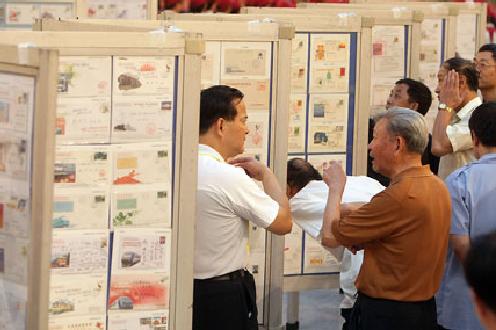Investors eye postage stamps
 0 Comment(s)
0 Comment(s) Print
Print E-mail
Shanghai Daily, July 2, 2011
E-mail
Shanghai Daily, July 2, 2011
|
|
|
Collectors crowd at a stamp show in Shanghai as the stamp market is heating up again.[Photo: Shanghai Daily] |
The postage stamp market was very hot before the 1997 Asian financial crisis and now it's heating up again. Experts advise what to watch for.
It's tantalizing to think that among those boxes of dusty old family papers and letters there might be a small fortune - a tiny, long-forgotten postage stamp.
The Chinese postage stamp auction market has recently heated up again, but experts warn what's in the attic probably isn't worth very much. Unless it's from the "cultural revolution" period (1966-76) or the Qing Dynasty (1644-1911). Significance, rarity and condition determine value.
Thirteen years ago in 1997, the postage stamp market in China was booming, and several stamp exchange markets emerged. But then the 1997 Asian financial crisis canceled hopes of a new age of profitable stamp collecting.
But in the last couple of years, long-forgotten objects such as coins, chops, ancient mirrors and old Moutai spirit have been bringing in money.
Rare postage stamps too are selling and collectors hope the enthusiasm lasts.
In 2009, one stamp titled "All the Landscape of the Country is Red," issued during the "cultural revolution," was auctioned for HK$3.68 million (US$472,845 today) in Hong Kong.
It originally sold for - 0.08 yuan at the time, about 1 US cent. That set a record for "cultural revolution" postage stamps.
A year later, another stamp issued during the "cultural revolution" broke the record and sold for HK$6.67 million.
Starting in 2010, the postage stamp market has become very, very hot.
"Don't be too optimistic," says a veteran postage stamp investor, declining to be quoted by name. "From years of experience, I understand the nature of stamp collecting."
One of his friends used to be called "the big brother and winner" in the stamp collecting arena when it boomed in 1997. "But he lost badly. Guess what he's doing now? Selling lottery tickets."
What accounts for the recent increase in auction prices?
"Take a careful look," says the investor. "It's only the stamps issued in early periods or the 'cultural revolution' that sell for high figures, since rarity always decides the value."
According to him, the daunting inflation rate has pushed the market up, encouraging ordinary people to invest.
"I often blame my parents for not collecting those old things years ago," says Wu Wei, a 35-year-old professional. "Back then, the prices of everything were reasonable and affordable. But the best time is gone."
Fortunately, he found a set of fabled zodiac golden monkey stamps issued in February 1980. "I'm going to sell if the price keeps rising," says Wu.
China issued 5 million Monkey stamps to commemorate the Year of the Monkey on the Chinese lunar calendar.
They are not that rare but they are familiar to many people and are considered a weather vane in the stamp market.
In 1997, a single monkey stamp sold for 1,800 yuan (US$278). In 2010 a single stamp sold for 11,700 yuan.
Early this year a whole set of stamps, 80 individual stamps, was auctioned for 1.1 million yuan.
That might explain why many Chinese people stand in long queues to purchase special edition zodiac animal stamps during the Chinese lunar new year. Every year, new stamps are issued.
The 1980 monkey stamp, and by extension similar zodiac stamps, are rooted in the minds of many Chinese people as an investment - accessible and affordable.
For example, the price of the dragon stamp issued in 2000 has increased 30 times in value; the rabbit stamp from 1999 has increased five times; last year's tiger stamp has almost tripled in value, according to collectors.
"If you look at its original face value, then a 30-fold increase is no big deal. I don't think much of those stamps, especially those issued after 1990," says Ji Chongjian, the owner of Shanghai Chongyuan Auction House. "The huge circulation and the boring subject are the reasons. Some stamps have a circulation of 10 or 20 billion, I really don't see any investment value there."
Of course, special limited-edition stamps, especially canceled ones, are a different story.
Ji suggests ordinary people should not get excited about stamp collecting.
"If it's your hobby, it's okay," he says. "But be wary of treating it as an investment."
According to him, there are only two stamp categories with investment potential, those issued during the Qing Dynasty and those issued during the "cultural revolution."
The 100 single stamps issued to mark the ascent to the throne of Pu Yi (1908-1912), China's last emperor, have been valued at 100,000 yuan each.
The rarity of the stamps issued during the "Cultural Revolution" make them valuable.
The message in all this: The postage stamp market and the flow of capital are not easy to figure out and there's considerable uncertainty.






